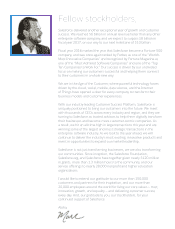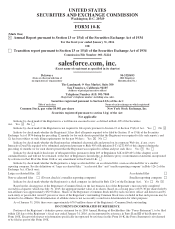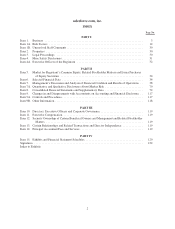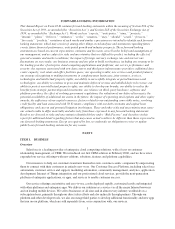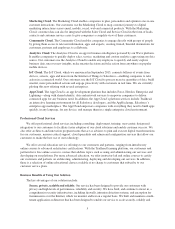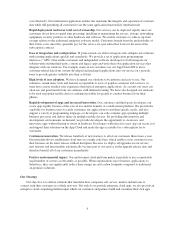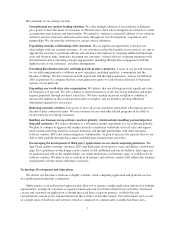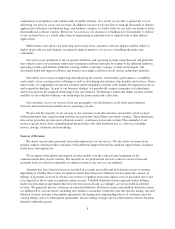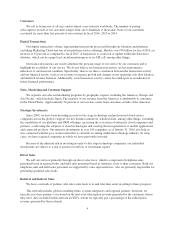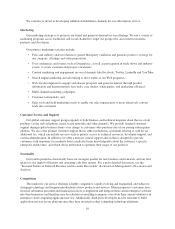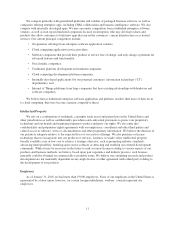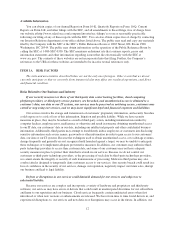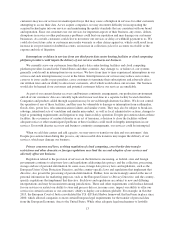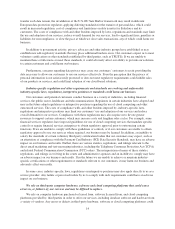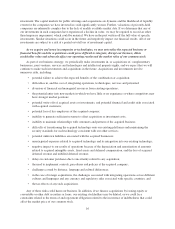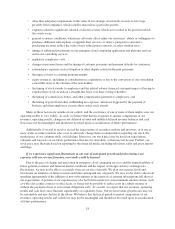Salesforce.com 2016 Annual Report Download - page 15
Download and view the complete annual report
Please find page 15 of the 2016 Salesforce.com annual report below. You can navigate through the pages in the report by either clicking on the pages listed below, or by using the keyword search tool below to find specific information within the annual report.combination of proprietary and commercially available software. As a result, we are able to spread the cost of
delivering our services across our user base. In addition, because we do not have to manage thousands of distinct
applications with their own business logic and database schemas, we believe that we can scale our business faster
than traditional software vendors. Moreover, we can focus our resources on building new functionality to deliver
to our customer base as a whole rather than on maintaining an infrastructure to support each of their distinct
applications.
Multi-tenancy also allows for faster bug and security fixes, automatic software updates and the ability to
deploy major releases and frequent, incremental improvements to our services, benefiting the entire user
community.
Our services are optimized to run on specific databases and operating systems using the tools and platforms
best suited to serve our customers rather than on-premise software that must be written to the different hardware,
operating systems and database platforms existing within a customer’s unique systems environment. Our
developers build and support solutions and features on a single code base on our chosen technology platform.
Our efforts are focused on improving and enhancing the features, functionality, performance, availability
and security of our existing service offerings as well as developing new features, functionality and services. From
time to time, we supplement our internal research and development activities with outside development resources
and acquired technology. As part of our business strategy, we periodically acquire companies or technologies,
and we incorporate the acquired technologies into our solutions. Performance, functional depth, security and the
usability of our solutions influence our technology decisions and product direction.
Our customers access our services from any geography over the Internet via all of the major Internet
browsers and on most major mobile device operating systems.
We provide the majority of our services to our customers from infrastructure operated by us but secured
within third-party data center hosting facilities located in the United States and other countries. These third-party
data center providers provide space, physical security, continuous power and cooling. The remainder of our
services operate from cloud computing platform providers who offer Infrastructure as a Service, including
servers, storage, databases and networking.
Sources of Revenue
We derive our revenues primarily from subscription fees for our service. We also derive revenues from
premier support, which provides customers with additional support beyond the standard support that is included
in the basic subscription fee.
We recognize subscription and support revenue ratably over the contract term, beginning on the
commencement date of each contract. The majority of our professional services contracts are on a time and
materials basis, for which we generally recognize revenue as the services are rendered.
Amounts that have been invoiced are recorded in accounts receivable and in deferred revenue or revenue,
depending on whether the revenue recognition criteria have been met. Deferred revenue primarily consists of
billings or payments received in advance of revenue recognition from subscription services described above and
is recognized as the revenue recognition criteria are met. Unbilled deferred revenue represents future billings
under our subscription agreements that have not been invoiced and, accordingly, are not recorded in deferred
revenue. We generally invoice customers in annual installments. Deferred revenue and unbilled deferred revenue
are influenced by several factors, including new business seasonality within the year, the specific timing, size and
duration of large customer subscription agreements, the timing and compounding effects of customer renewals,
varying billing cycles of subscription agreements, invoice timing, foreign currency fluctuations and new business
linearity within the quarter.
8



